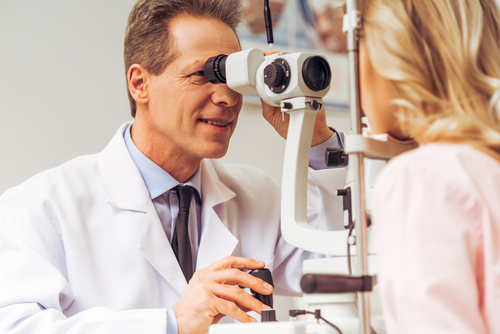
Keratoconus is an eye disease that affects your cornea. With the possibility of causing vision loss, it is essential to be aware of this ocular condition.
Keep reading to learn more about the causes, symptoms, and treatment of keratoconus!
How Does Keratoconus Affect the Eye?
When you have keratoconus, your cornea thins and changes shape. The cornea is the transparent front part of your eye and is responsible for focusing light so you can see.
Keratoconus causes your cornea to gradually thin and form a cone-shaped bulge. In most cases, keratoconus develops in puberty and continues to progress for a decade or longer.
It usually affects both eyes, although one eye may be more affected than the other.
What Are the Symptoms of Keratoconus?
In its early stages, many individuals with keratoconus do not notice any symptoms. As it progresses, they may begin to experience:
- Blurry vision
- Glare and halos around lights
- Poor night vision
- Eye irritation
- Headaches from eye strain
- Light sensitivity
- Sudden worsening of vision
- Frequent prescription changes
What Causes Keratoconus?
Unfortunately, the exact cause of keratoconus is not known. However, it is thought that you can be genetically predisposed to it.
A family history of keratoconus can increase your chances of developing it too. Eye rubbing is linked to keratoconus, as is chronic inflammation, for example, from allergies.
Continuous irritation may play a role in the breakdown of corneal tissue that can lead to this ocular disease. Certain conditions can also make it more likely that you will develop keratoconus.
There’s evidence to suggest that conditions like retinitis pigmentosa and Ehlers-Danlos syndrome may have a connection with keratoconus.
How Do Eye Doctors Diagnose Keratoconus?
If you notice any of the above symptoms, you should schedule an appointment with your eye doctor as soon as possible. They will be able to conduct a thorough exam and evaluate the state of your corneas.
They will also discuss your medical history in order to determine the cause of your symptoms. Your eye doctor may use special tests to diagnose keratoconus.
They may take a detailed image that maps out your eye, paying particular attention to the curvature of your cornea. A microscope called a slit-lamp exam also allows them to take a close look at your eyes and detect corneal abnormalities.
Lastly, a pachymetry test measures where your cornea is thinnest.
How Is Keratoconus Treated?
In its early stages, the most common treatment for keratoconus is glasses to correct your refractive error. When symptoms are mild, this is typically enough for you to see clearly.
Your eye doctor may recommend wearing special contact lenses when it progresses to a certain point and glasses are no longer sufficient. Corneal collagen cross-linking is a treatment that uses a vitamin solution and UV light to strengthen the cornea.
When the light activates the solution, new collagen links form, which can strengthen your cornea and prevent your eye from bulging further. In advanced keratoconus, your eye doctor may recommend implanting intacs.
These are plastic rings that reduce the curvature of the cornea. In severe cases, you may require a corneal transplant.
During a corneal transplant, your eye doctor will use a healthy cornea from a donor and replace your damaged cornea. Treatments like corneal collagen cross-linking may help prevent your need for a corneal transplant.
Are you experiencing any signs of keratoconus? Schedule an appointment at EnVue Eye & Laser Center in Oxon Hill, MD, today.









